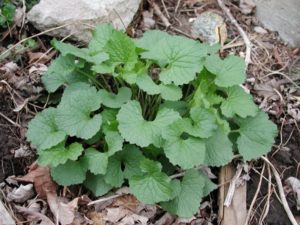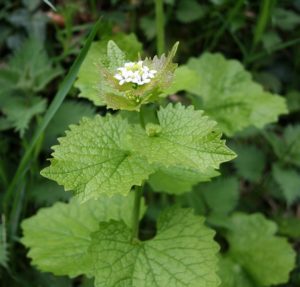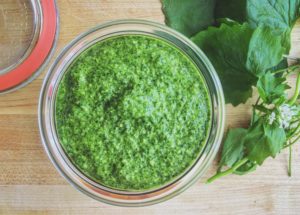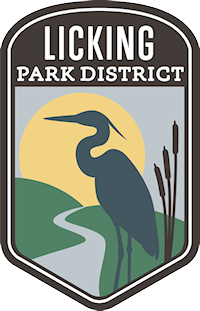The 2020 Licking Park District Garlic Mustard Challenge (with a recipe!)
The villain: an edible plant that smells like garlic, can produce up to 8,000 seeds per plant, and is capable of taking over vast areas of woodland floor. Our mission: eradication.
Garlic Mustard, Alliaria petiolata, is a flowering plant in the mustard family native to Europe, western and central Asia and north-western Africa. It goes by many common names: hedge garlic, sauce-alone, jack-by-the-hedge, poor man’s mustard, jack- in-the-bush, garlic root, and mustard root. It is called garlic mustard because the leaves have a garlic smell when they are crushed. Unfortunately, outside of its native range, garlic mustard is highly invasive.

So what qualities must a species have to be considered invasive? An invasive species can be any kind of living organism—a plant, insect, fish, fungus, or bacteria—that is not native to an ecosystem and causes harm. The key word in that definition is harm. Species that grow and reproduce quickly, have few natural predators, and spread aggressively are detrimental to the areas where they are introduced, taking over the new habitat. This creates a cascade effect through the ecosystem, resulting in fewer native species. The repercussions can harm the environment, human health, and the economy. The annual US cost from invasives is $120 billion, with over 100 million acres being affected (i.e. the size of California).
Garlic mustard was first discovered in the USA in 1868. It spread slowly at first, not reaching across the country until 1959. However about 40 years ago it began to proliferate alarmingly, accelerating from an estimated 141 square miles a year to over 2470. How did it become so invasive?
Remember species that grow and reproduce quickly, have few natural predators, and spread aggressively can often become invasive outside of their native range. Garlic mustard has many of these traits. Garlic mustard is biennial, meaning it has a two year life cycle. In that time, one plant can produce up to 8,000 seeds, which translates into 100,000 seeds per square meter which are easily dispersed by wind and water. Germination rate is close to 100% and up to 24,000 seedlings per square meter have been counted. A high shade tolerance allows this plant to invade high quality, mature woodlands, where it can form dense stands that shade out native plants such as wildflowers. In addition, garlic mustard is allelopathic. Essentially it engages in a type of chemical warfare with other native plants, producing compounds that inhibit the growth of beneficial soil fungi (mycorrhizae) and prevents seeds of other native plant species from germinating. Not many species here in the United States eats garlic mustard, though it is edible to humans. We talk more about that in a little bit.
Here in Ohio, Garlic Mustard is found in all counties. At the Licking Park District it can be found at every park and along portions of the bike trails. Eradicating garlic mustard is easy work, but takes time and vigilance. Garlic mustard can sprout up even when you’re sure that you’ve gotten every single one (Did we mention the seeds stay viable for over 5 years?). Which is why this must be a group effort!
As such the Licking Park District is excited to start our Garlic Mustard Challenge, modeled after The Garlic Mustard Challenge of New England. The intention is that this will be a collaborative effort where anyone and everyone can help make a difference to our shared green spaces. The ultimate goal in removing garlic mustard is to prevent seed development and spreading until the existing seed bank is depleted. To help, we have provided a fact sheet, informational video, and reporting form that are available on our website, LickingParkDistrict.com, under the Volunteer tab. As we are able, we will also host volunteer events at our parks. For now we urge you to use all recommended social distancing guidelines while participating.

Garlic mustard is relatively straightforward to identify. Its heart-shaped, rounded, or triangular leaves with scalloped edges, petite white 4-petaled flowers, and garlic odor combine to make it fairly distinctive. First year plants have just a rosette of smaller round or kidney-shaped leaves with rounded, scalloped edges low to the ground. Leaf venation is pronounced and the leaves are often a deep and distinct shade of green. Second year plants send up a flower stem (petiole) that can reach up to three feet. The leaves are often a bit more triangular with sharper scallops. This stem terminates in a small cluster of tiny white flowers with four petals and eventually elongates into a seedpod stem.

The best way to get rid of garlic mustard is manually; i.e. pulling it up and discarding it. Try to pull up the plants before they set seed, because seeds can be disbursed as the pant is pulled. Try to get the entire plant, including the long tap root. The plant can grow back if the entire root is not removed. A good time to pull garlic mustard is after a rain as softer soil makes it easier to pull. After you have pulled the plants, bag them up and throw them out with your garbage. Or you can try a recipe or two. That being said ALWAYS be 100% certain of your plant identification before eating any wild plant.
Garlic Mustard was first introduced during the 1800s for medicinal and culinary purposes. According to Ediblewildfood.com the flowers, leaves, roots and seeds are all edible. “Leaves in any season can be eaten but once the weather gets hot, the leaves will taste bitter. Flowers can be chopped and tossed into salads. … Garlic mustard roots taste very spicy somewhat like horseradish.” Its leaves are rich in vitamin C and A, and one of the most common recipes you will find is for Garlic Mustard Pesto. Various uses mentioned also include sauce for meat, use like lettuce for flavoring sandwiches, mix in salads, eat with salted fish, and use as a stuffing in pork. The seeds make a very fiery mustard.
We hope you take the challenge!

We have included a recipe from The Forager’s Feast: How to Identify, Gather, and Prepare Wild Edibles
Wild Greens Pesto with Garlic Mustard Recipe
1/4 cup walnuts or pine nuts
1 teaspoon cleaned field garlic bulbs OR 1 clove garlic, peeled
1 cup garlic mustard leaves
1 cup chickweed (Stellaria media) or fresh parsley leaves
1 cup extra-virgin olive oil
1/4 cup grated parmesan or romano cheese (or a pinch of nutritional yeast if you’re keeping it vegan)
Salt to taste
Put the nuts and garlic into a food processor or blender. Blend until the garlic is minced and the nuts are finely chopped.
Add the garlic mustard leaves and the chickweed or parsley. Pulse a few times to coarsely chop the leaves.
With the processor or blender running, add the olive oil in a steady pour, stopping 2 or 3 times to scrape down any leaves that are clinging to the sides of your machine.
Add the cheese, if using, and blend for a few seconds longer. Add a little more oil if it seems too thick, more nuts or cheese if it’s more liquid than you’d like. Add salt to taste.
Toss with pasta, add a spoonful to top a soup or stew, serve on top of polenta, or use as a dipping sauce for a good, crusty bread.
